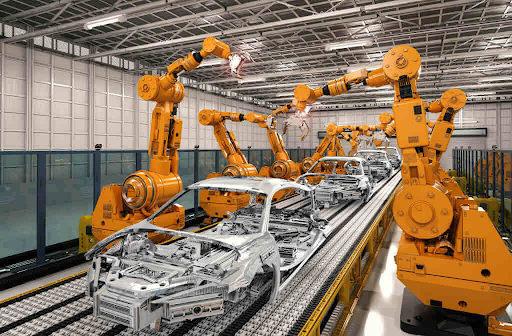The reality of robotics
Simone Rothaupt. 12/11/2020

Popular culture has long warned humankind that robots will soon take over. From Pixar movie “WALL-E” to the science-fiction book “Humans, Bow Down,” robots are seemingly within reach of reigning the world. However, in the InterSTEM Speaker Series, Professor Heiko Hoffmann debunked this fear and revealed the true state of robotics to be far from those dystopian expectations.
Although not as advanced as Hollywood’s predictions, robots are still present across the globe. According to The Robot Report, robots have been implemented into various industries, such as automation, food, agriculture, healthcare and manufacturing, as the technology can perform precisely and efficiently to pick and place motions in controlled settings. In just the third quarter of 2019, Industry Week reported that orders for robots totaled over $1.3 billion, demonstrating how widespread robotics has become.
Robots can vary in structure and function, but Dr. Hoffmann clarifies that most robots, especially ones in manufacturing, consist of robotic arms on a moving unit that utilizes linear grippers which open and close. For example, the National Aeronautics and Space Administration (NASA) explains that their space exploration robots have linear grippers and wheels, as well as complex machinery like drills to conduct soil analysis.
Several products that seek to address the issues of current robots, such as limited flexibility and autonomy, are under development. For instance, Boston Dynamics has designed a human-sized robot named Atlas that specializes in locomotion, such as backflips and jumping, and can move up to 1.5 meters per second. In addition, WIRED explains that the Berkley robot for the Elimination of Tedious Tasks (BRETT) employs imitation and reinforcement learning to teach itself new skills on its own, such as putting pegs into holes.
But how do these robots work? According to Dr. Hoffmann, robots function using three steps. First, the robot must understand its location in a 3D and relative to the objects around it, a process which includes examining the depth of its surroundings, distinguishing the outline of objects and interpreting its scene through a computer. A robot’s perception system often includes a depth sensor, light detection and ranging (Lidar) and cameras. Second, the robot must plan several collision-free trajectories and choose the fastest or most direct option. Finally, the robot must execute movements by controlling the power and speed of the actuators and motors. A robot often has to simultaneously perform all three tasks in order to adapt to new environments and obstacles.
According to WIRED, sensors, actuators and artificial intelligence (AI) are responsible for allowing robots to develop so much in recent years. Sensors, especially Lidar, have enabled robots to obtain better quality sensory data and thus, quickly identify the world around them. Actuators, such as the ones powered by electricity flowing through oil-fueled pouches, have given robots greater strength and smoother mobility. AI allows for information and complex calculations to be processed rapidly in real-time and enables the machine to ‘learn’ from its mistakes. Together, these three innovations improve the accuracy, flexibility and power of robots.
In order for robots to become commercially viable and more effective, The Robot Report explains that robots need to become cheaper, more flexible, more durable, better suited for handling delicate materials, be able to communicate faster and have an improved sense of touch. According to MIT Technology Review, transfer learning could reduce the cost of testing robots without sacrificing quality. Transfer learning is where robots are first trained with higher-grade sensors and in a controlled environment. Afterward, these robots are able to apply what they learned from the previous testing, and they can then navigate a new chaotic environment with poor sensors faster than a robot without prior training. Furthermore, testing conducted by the Toyota Research Institute has developed a plausible technique for improving a robot’s ability to handle delicate objects. By using grippers with air-filled elastic bubbles instead of metal or other rigid materials, a robot could gently hold objects. While these solutions will help to address some of the current issues with robots, additional research is required to advance robots enough for complete integration into our everyday lives.
For the future of robots, Dr. Hoffman detailed some viable achievements we may see in the coming years. Fully autonomous driving has become a realistic possibility because more companies like Tesla are investing in this area, and researchers continue to improve machine learning and computer vision. Fully autonomous warehouses and distribution centers, like Amazon, are potentially within reach as the relatively controlled environment of a shipping center is the optimal environment for a robot to function. Moreover, the Robotics Business Review claims the future may see a shift in more automation in manufacturing, especially for wielding together metal and handling rigid objects. According to ARK Invest, although initially more costly, the use of robots in manufacturing has the potential to break even in less than a year and lower employee injury rates. Although real robots do not resemble pop culture, they hold great future potential for enhancing our lives.
Simone Rothaupt Simone is a sophomore at Thousand Oaks High School in Ventura, California. She is interested in exploring STEM related topics, such as medicine, and she also hopes to spread this passion to others through writing.
Cover Photo: (iStockphoto/iLexx)

Simone is a sophomore at Thousand Oaks High School in Ventura, California. She is interested in exploring STEM related topics, such as medicine, and she also hopes to spread this passion to others through writing.